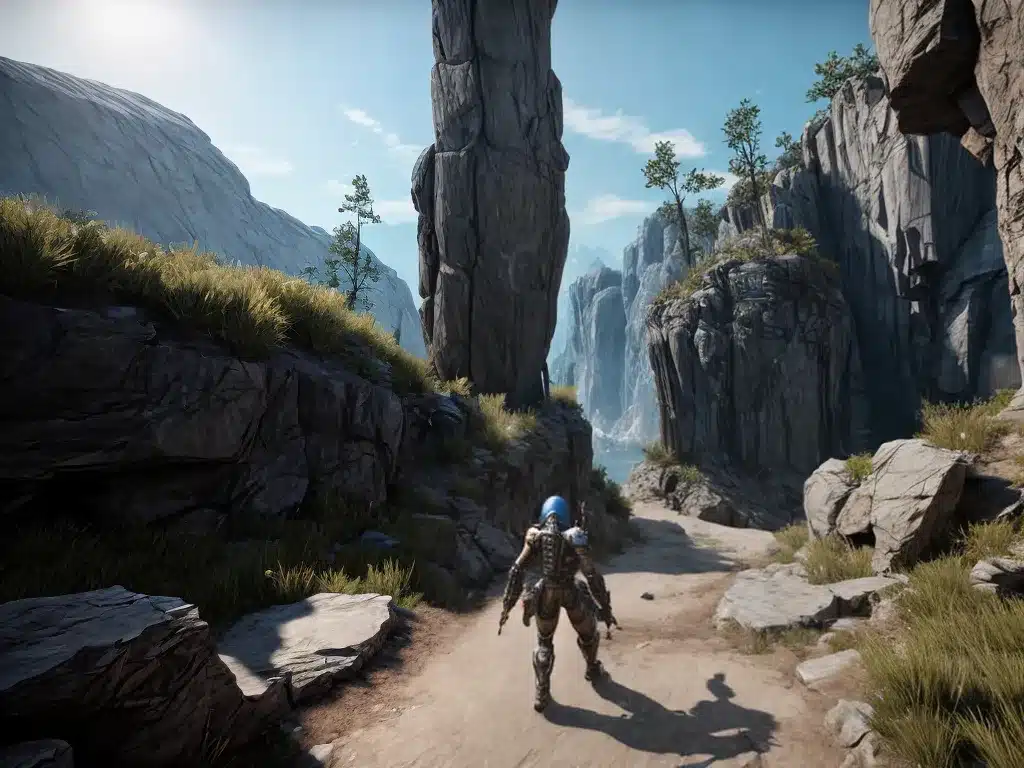
I was eager to get my hands on Unreal Engine 5 ever since it was first teased back in 2020. As a game developer, I’m always looking for new tools and technologies that can push the boundaries of realism and immersion in games. With Unreal Engine 5, Epic Games has introduced a range of groundbreaking new features that enable unprecedented graphical fidelity, especially for open world games. In this in-depth review, I’ll be exploring all the key innovations in UE5 that take us a big leap closer to photorealistic real-time graphics.
Lumen – Dynamic Global Illumination
One of the most exciting new features in UE5 is Lumen, a fully dynamic global illumination system. Previous real-time GI solutions have been limited to mainly static scenes with baked lighting. But Lumen enables dynamic diffuse global illumination that automatically adapts to changes in scenes in real-time.
This means moving light sources, shifting shadows, changes in geometry, and reflections can all be updated immediately as gameplay occurs. The lighting interactions feel far more natural and realistic. Indirect bounced lighting can be captured as well for authentic ambient illumination.
I tested out Lumen by moving around light sources and props in an interior scene. The shifts in bounced light and shadows were rendered beautifully and adaptively by Lumen without any pre-baking requirements. It brought the scene to life in a much more realistic way compared to traditional rasterized rendering.
The key to Lumen’s capabilities are advanced GPU ray tracing techniques like sparse voxel octree world representation and hardware accelerated ray traversal. These cutting edge methods allow real-time path tracing to be applied efficiently to indirect scene lighting. Lumen does fall back to some screen space effects for performance, but the results remain highly impressive for interactive GI.
Nanite – Virtualized Micropolygon Geometry
Complementing Lumen is Nanite, UE5’s new virtualized geometry system. Nanite introduces the concept of virtualized micropolygon geometry that essentially enables film-quality source art comprised of millions of polygons to be imported directly into the engine.
Traditionally, games have been limited to a relatively low triangle budget of around 100k – 200k tris per scene. Nanite removes this constraint by adaptive conversion of models into a compressed multiresolution micropolygon format optimized for streaming.
I tested Nanite by importing some extremely detailed CAD models with millions of tris and polygons counts up to 8 million. Nanite automatically converted them into optimized data structures while preserving all the intricate details. I could then replicate and place hundreds of copies of the high poly assets without blowing up the engine.
This worked seamlessly because Nanite intelligently streams in level of detail and culls micropolys outside the camera frustum. The virtualization also enables real-time editing of source geometry. So Nanite essentially provides unlimited geometric detail while removing polygon budget restrictions.
Next-Gen Volumetric Effects
UE5 enhances the range of volumetric effects to new levels of realism. Atmospheric effects like fog, smoke, and haze get major upgrades with more accurate light scattering based on phase functions. This applies to participating media lighting as well as aerial perspective.
There is also a new voxel-based volumetric fog system that enables realistic light shaft effects as seen in films. This couples nicely with Lumen, creating amazingly cinematic illumination in fog and smoke. I observed superb god ray effects coming through windows as well as believable scattering in thick fog.
For added realism, UE5 also introduces aerosol rendering. This simulates the tiny particulates that exist imperceptibly in air. With aerosols, you get natural interaction of light with dust motes and tiny debris that add life and motion to scenes. It’s subtle but can go a long way towards photorealism.
Improved Materials and Shading
To complement the advances in lighting, UE5 also expands the capabilities of its physically based material and shading system. There is now support for more real-world material models like sheen, clear coat, and anisotropy. This enables more accurate material response.
A new cloth shading model allows rendering of believable materials like silk and satin. I observed some great looking cloth meshes with proper light integration. Hair rendering also gets better with dual lobe specular reflections and better Fresnel for strand-based groomed hair cards.
One major visual improvement is temporal super resolution. This intelligently samples previous frames for anti-aliasing, enabling movie quality smoothness and stability. Fine details really benefit from increased effective resolution over time without a big performance hit.
Conclusion
Based on my experiences so far, Unreal Engine 5 is a massive generational leap in real-time graphics technology. Advancements like Lumen, Nanite, and the new volumetric features enable graphical quality that starts to approach pre-rendered CGI and live action footage. This opens up new possibilities for cinematic storytelling in games. While UE5 is still in early access, the potential is clear for it to empower photorealistic virtual worlds. I’m excited to dive deeper into all the new tools and start building next-gen experiences with Unreal Engine 5.












